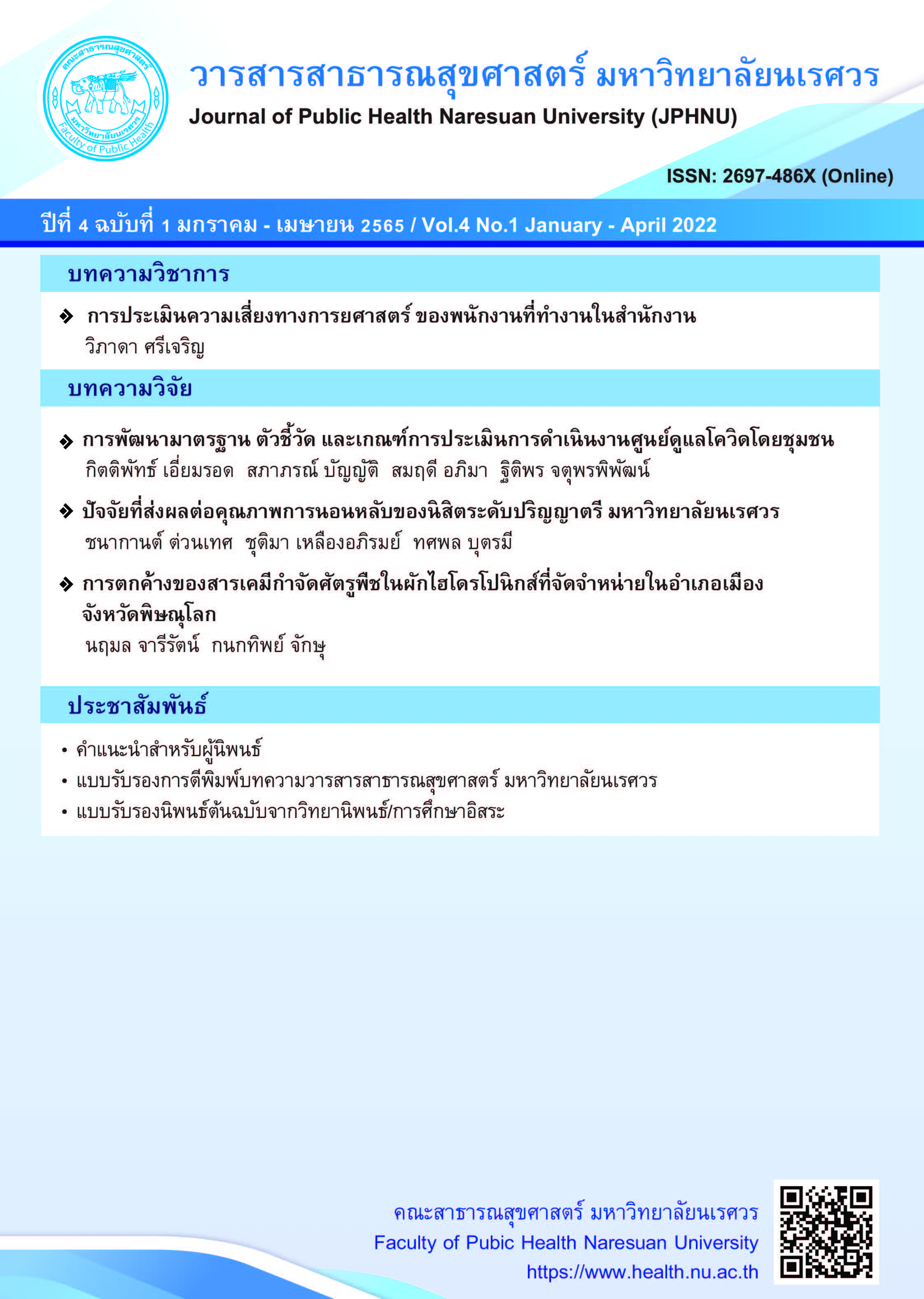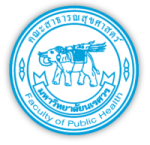Factors affected to sleep quality among undergraduate students Naresuan University
Keywords:
Stress, Sleep quality, Students, Naresuan UniversityAbstract
This descriptive cross-sectional study aimed to 1) study sleep quality, 2) identify factors affecting sleep quality, and 3) compare the sleep quality of undergraduate students between three major groups. Data were collected from 420 undergraduate students at Naresuan University. The research instrument was a questionnaire that included 4 parts as follows: 1) demographic data; 2) sleep disturbance factors; 3) stress test (SPST-20) and, 4) Pittsburgh's sleep quality questionnaire. Data were collected from March to August 2021. Data were analyzed by one-way ANOVA and Multiple Linear Regression statistics.
The results showed that most of the participants (75.0 percent) had poor sleep quality. Moreover, it was found that stress scores, smoking, gender, discomfort bedding, and the duration of smartphone use before bedtime were statistically significant to predict the sleep quality of undergraduate students, at Naresuan University, with the accounted for 23.4 percent (p-value < 0.05). The highest predictor was stress (Beta = 0.361). There was no significant difference in sleep quality between the three major groups
(p-value > 0.05). The findings from this study suggested that the university administration should be concerned with appropriately managing the academic schedule and activities to decrease the stress, which was the highest predictive factor to increase the sleep quality of the student.
References
Arayasinlapathon, N., Somkumlung, P., & Phoobunerb, J. (2017). Factors affecting sleep quality among nursing students in one college of nursing. Journal of Phrapokklao Nursing College, 28(1), 38-50. (in Thai)
Shad, R., Thawani, R., & Goel, A. (2015). Burnout and sleep quality: A cross-sectional questionnaire-based study of medical and non-medical students in India. Cureus, 7(10), e361. doi:10.7759/cureus.361
Buboltz, W. C. Jr., Brown, F., & Soper, B. (2001). Sleep habits and patterns of college students: A preliminary study. Journal of American College Health, 50(3), 131-135.
Chanamanee, P., Taboonpong, S., & Intanon, T. (2006). Sleep quality and related factors among university students in southern Thailand. Songklanagarind Medical Journal, 24(3), 164-173. (in Thai)
Department of Mental Health. (2011). Suanprung Stress Test of Department of Mental Health (SPST-20). Retrieved Febuary 16, 2021, from http://envocc.ddc.moph.go.th/uploads/%E0%B8%9B%E0%B8%A3%E0%B8%B0%E0%B8%8A %E0%B8%B8%E0%B8%A1/20-21_11_61/C_4.pdf
Division of Sleep Medicine at Harvard Medical School. (2008). Sleep and memory. Retrieved February 2, 2021, from http://healthysleep.med.harvard.edu/need-sleep/whats-in-it-foryou/memory
Durmer, J., & Dinges, D. (2005). Neurocognitive Consequences of Sleep Deprivation. Semin Neurol, 25, 117-29.
Jirapramukpitak, T., & Tanchaisawat, W. (1997). Sleep disturbances among nurses of Songklanagarind Hospital. Journal of the Psychiatrist Association of Thailand, 42(3), 123-132. (in Thai)
Karnchanakomate J., Wongsawat P. (2020). Sleep quality and related factors among university students. Journal of Nursing Science & Health, 43(2), 135-145. (in Thai)
Krejcie, R. V., & Morgan, D. W. (1970). Determining sample size for research activities. Educational and Psychological Measurement, 30(3), 607-610.
Li, W., Yin, J., Cai, X., Cheng, X., & Wang, Y. (2020). Association between sleep duration and quality and depressive symptoms among university students: A cross-sectional study. PloS one, 15(9), e0238811.
Luqman, R., Ghous, M., Nawaz, J., Ali, A., Kanwal, M., & Yaqoob, I. (2020). Factors associated with sleep deprivation and their impact on academic performance of hostelites of twin cities of Pakistan. The Journal of the Pakistan Medical Association, 70(5), 851-855.
Mahatnirunkul, S., Pumpaisanchai, W., & Tapunya, P. (1997). Creating a stress gauge of Suanprung. Bulletin of Suanprung, 13(3), 1-20. (in Thai)
Maheshwari, G., & Shaukat, F. (2019). Impact of poor sleep quality on the academic performance of medical students. Cureus, 11(4), e4357-e4357. doi:10.7759/cureus. 4357
Naresuan University. (2021). Naresuan university students activities calendar 2020. Retrieved Febuary 16, 2021, from https://www.nu.ac.th/?page_id=504
Potaros, D. (2017). Factors related to sleeping quality of nursing students. The Journal of Faculty of Nursing Burapha University, 25(1), 25-36. (in Thai)
Reangsing, C. (2007). Quality of sleep and mental health of professional nurses in government hospitals Bangkok Metropolis. Thesis of Master of Science, Chulalongkorn university, Bangkok. (in Thai)
Purani, H., Friedrichsen, S., & Allen, A. M. (2019). Sleep quality in cigarette smokers: Associations with smoking-related outcomes and exercise. Addict Behav, 90, 71-76.
Sleep society of Thailand. (2016). Assorted sleep problems. Retrieved Febuary 24, 2021, from http://sasuksure.anamai.moph.go.th/ (in Thai)
Techatawiwan P. (2012). Caring about rest and sleep. Retrieved Febuary 2, 2021, from https://www.elnurse.ssru.ac.th/petcharat_te/
The Good Body. (2018). Sleep statistics reveal: The (Shocking) Cost To Health And Society. Retrieved February 2, 2021, from https://www.thegoodbody.com/sleep-statistics
Downloads
Published
How to Cite
Issue
Section
License
Copyright (c) 2022 Journal of Public Health Naresuan University

This work is licensed under a Creative Commons Attribution-NonCommercial-NoDerivatives 4.0 International License.
The published article is copyrighted by the Journal of Public Health and Health Sciences Research.
The statements that appear in each article in this academic and research journal are the personal opinions of each author and are not related to Naresuan University and other faculty members in the university. Responsibilities regarding each article are the responsibility of each author.






